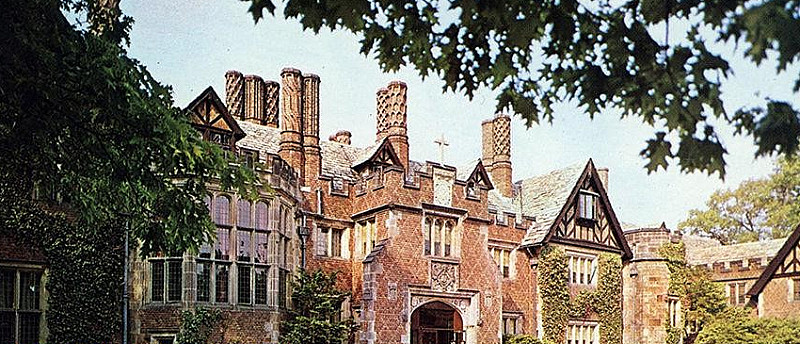Ronaele Manor
Elkins Park, Montgomery County, Pennsylvania

This house is best associated with...
"Less Palatial... But Equally Impressive In Its Own Right"
Eleanor was an heiress who'd lost both her father and her brother on the Titanic. Her husband, Eugene, was a banker and former Davis Cup captain. Though they lived at Kulp House for 12 years, they spent that time planning their new mansion. Tearing down Cooke's late 19th century showpiece, Ogontz, the Dixons replaced it with an English Tudor-Revival manor that they named "Ronaele" which is "Eleanor" spelt backwards. In her own words, Eleanor had set out to build a house, "less palatial than either Miramar or Lynnewood Hall, but equally impressive in its own right". She succeeded.
Tudor-Revival at its Best
Spread out over differing levels and reaching three stories in places, the slate roof was interspersed with 28 chimneys marked by their own unique brickwork design and motif. The 173-foot long mansion was built of bricks with varying hues of color that were laid out in patterns concurrent with original Tudor style; and, in keeping with that period the door and projecting window frames were made of limestone. Mr Dixon was a scion of an old and notable Scottish family and above the main entrance door made of oak, 4-inches thick (believed to have been carved from choir stalls found in an English monastery), Trumbauer incorporated the Dixon coat-of-arms and motto, "Fortune Favours the Bold".
Many of the rooms featured antique-panelling and the panelling found in the living room had been removed from a hunting lodge belonging to King James I (1566-1625) of England. The most striking feature was said to be the Tudor staircase - similar in style to originals found at Blickling Hall and Hatfield House - the landing of which was lit by a two-tiered brass chandelier. Though built as an ancient home, the house contained modern amenities by way of 13-bathrooms, an elevator and an indoor badminton court. The Dixons employed a domestic staff of 24, and many more on the estate.
Mr Dixon's Collection of Heraldic Stained Glass
Dixon's collection was sourced from a variety of old European manors and castle, including among them Windsor Castle, Herstmonceux Castle, Wroxton Abbey and Costessey Hall. Every room in Ronaele was fitted with panes from his unrivalled collection and sixty-six of them can still be seen today at the Philadelphia Museum of Art.
The Gardens and the "Dendrobium Ronaele" Orchid
The estate incorporated a cattle farm and there were numerous outbuildings including a tea house, 8-room butler's cottage, garage and servant's quarters, all designed by Trumbauer. Aside from the greenhouses, there was also a swimming pool - out of sight but in comfortable proximity to the house - tennis courts and an indoor badminton court.
Moving Homewood & The Christian Brothers of LaSalle
In 1949, convenience necessitated that the Dixons move to Homewood on Chestnut Hill. On moving, they took with them the living room's fireplace and its 16th century panelling that was refitted into Homewood. The following year, Mrs Dixon sold Ronaele Manor to the Christian Brothers of La Salle College. They used the mansion to house members of their institute who were studying in the Philadelphia area, renaming it "Anselm Hall".
In 1973, the Brothers removed many of Ronaele's interior features for display at the La Salle University Art Museum before selling the property for development. After a spirited battle by local preservationists - and despite it having been declared an historic site - the mansion was unceremoniously torn down in 1974 and the land built upon. Several of the Trumbauer-designed outbuildings survive, including the five-bedroom "Pheasant Run".
You May Also Like...
Categories
Styles
Share
Connections
There are 6 members connected to this house, are you? Connect to record your link to this house. or just to show you love it! Connect to Ronaele Manor →
tom arnall loves Ronaele Manor
Lauren loves Ronaele Manor
Thomas Hanlon loves Ronaele Manor
Charles Hendricksen lives in Ronaele Manor
Dale Heller loves Ronaele Manor
Ron Gurney frequents Ronaele Manor
Ron Gurney loves Ronaele Manor
















